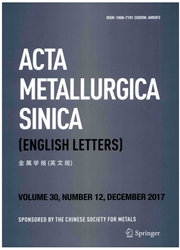

 中文摘要:
中文摘要:
减少低档锰二氧化物矿石小团上的调查被把小麦梗用作 reductant 执行。象在减小过程的粒子尺寸,生物资源 / 矿石比率,加热的率,氮流动率,温度和时间那样的减小百分比的主要影响因素被讨论。在不同阶段的矿石粒子也是的锰二氧化物的形态学和部件由扫描电子显微镜学(SEM ) 和精力分析了散 X 光检查光谱学(版本) 。结果显示出减小温度的增加,粒子的时间,生物资源 / 矿石比率,和减少缩放,显著地加热率和氮流动率罐头提高减小效率。锰矿石运动的减小被从表面过去到矿石粒子的核心的气体的减少的 volatiles 的三维的集体散开控制。激活精力 E 和频率因素 A 被计算是 24.15 kJ 吗??
 英文摘要:
英文摘要:
An investigation on reducing low-grade manganese dioxide ore pellets was carried out by using wheat stalk as reductant. The main impact factors of reduction percent such as particle size, biomass/ore ratio, heating rate, nitrogen flow rate, temperature and time in reduction process were discussed. The morphology and component of manganese dioxide ore particle at different stages were also analyzed by scanning electron microscopy (SEM) and energy dispersive X-ray spectroscopy (EDS). The results show the increase of the reduction temperature and time, biomass/ore ratio, and the decrease of particle size, heating rate and nitrogen flow rate can significantly enhance reduction efficiency. The reduction kinetic of the manganese ore is controlled by three-dimensional mass diffusion of gaseous reductive volatiles passing from the surface to the core of the ore particles. The activation energy E and frequency factor A were calculated to be 24.15 kJ.mol^-1 and 166 min^-1, respectively. Biomass pyrolysis volatiles adsorbed onto the surface of the ore particle leads to serious variation of the microstructures and chemical composition of the manganese ore particles.
 同期刊论文项目
同期刊论文项目
 同项目期刊论文
同项目期刊论文
 Study in reduction-roast leaching manganese from low-grade manganese dioxide ores using cornstalk as
Study in reduction-roast leaching manganese from low-grade manganese dioxide ores using cornstalk as 期刊信息
期刊信息
